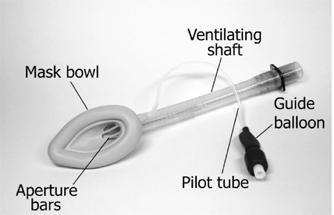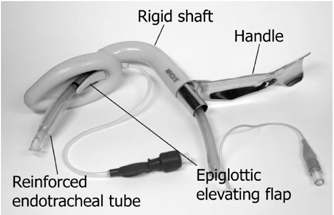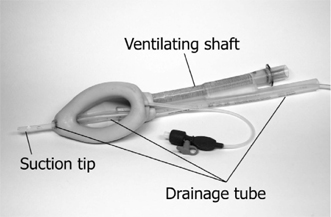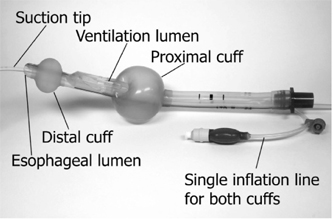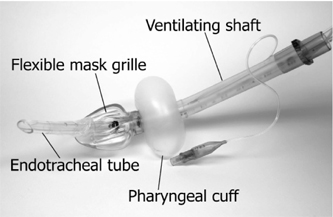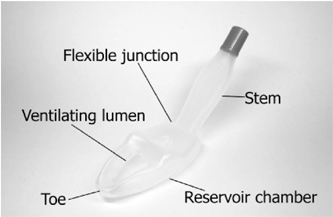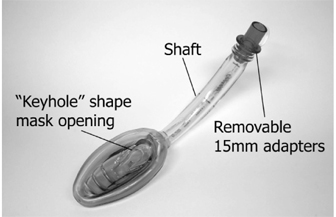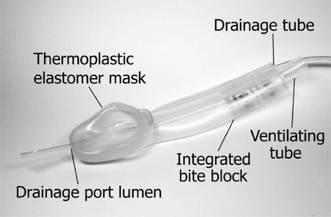J Korean Med Assoc.
2015 Oct;58(10):905-914. 10.5124/jkma.2015.58.10.905.
Safety and clinical usefulness of supraglottic airway device
- Affiliations
-
- 1Department of Anesthesiology and Pain Medicine, Chung-Ang University College of Medicine, Seoul, Korea. roman00@naver.com
- KMID: 2195106
- DOI: http://doi.org/10.5124/jkma.2015.58.10.905
Abstract
- Supraglottic airway devices (SADs) are used to keep the upper airway open and provide adequate ventilation and oxygenation. Their use is increasing, and various kinds of SADs have been introduced to routine clinical practice. This review describes the characteristics and illustrates the use of those SADs that have been introduced to and/or are available in Korea. Particular attention is paid to the use of SADs in special clinical settings such as a difficult airway, prehospital care, resuscitation, and intubation. There has been a paradigm shift in the emphasis of difficult airway management from endotracheal intubation to adequate ventilation and oxygenation. SADs have proven to be useful alternatives to tracheal intubation; however, they also have potential disadvantages such as the risk of regurgitation of gastric contents and pulmonary aspiration. Advances in SAD design such as drainage tubes or double cuffs, which lessen the possibility of harmful events and complications, are discussed. The evolution and widespread use of SADs have changed the clinical theory and practice of airway management. Clinicians should be aware of the strengths and limitation of each SAD and understand the limited evidence currently available for guidance.
MeSH Terms
Figure
Reference
-
1. Benumof JL. The glottic aperture seal airway: a new ventilatory device. Anesthesiology. 1998; 88:1219–1226.
Article2. Maltby JR, Loken RG, Watson NC. The laryngeal mask airway: clinical appraisal in 250 patients. Can J Anaesth. 1990; 37:509–513.
Article3. Tanaka A, Isono S, Ishikawa T, Sato J, Nishino T. Laryngeal resistance before and after minor surgery: endotracheal tube versus Laryngeal Mask Airway. Anesthesiology. 2003; 99:252–258.4. Brain AI. The laryngeal mask: a new concept in airway mana-gement. Br J Anaesth. 1983; 55:801–805.5. Brain AI. The development of the Laryngeal Mask: a brief history of the invention, early clinical studies and experimental work from which the Laryngeal Mask evolved. Eur J Anaesthesiol Suppl. 1991; 4:5–17.6. Verghese C, Berlet J, Kapila A, Pollard R. Clinical assessment of the single use laryngeal mask airway: the LMA-unique. Br J Anaesth. 1998; 80:677–679.
Article7. Alexander CA. A modified Intavent laryngeal mask for ENT and dental anaesthesia. Anaesthesia. 1990; 45:892–893.
Article8. Bailey P, Brimacombe JR, Keller C. The flexible LMA: literature considerations and practical guide. Int Anesthesiol Clin. 1998; 36:111–122.9. Baskett PJ, Parr MJ, Nolan JP. The intubating laryngeal mask: results of a multicentre trial with experience of 500 cases. Anaesthesia. 1998; 53:1174–1179.
Article10. Young B. The intubating laryngeal-mask airway may be an ideal device for airway control in the rural trauma patient. Am J Emerg Med. 2003; 21:80–85.
Article11. Brain AI, Verghese C, Strube PJ. The LMA 'ProSeal': a laryngeal mask with an oesophageal vent. Br J Anaesth. 2000; 84:650–654.12. Garcia-Aguado R, Vinoles J, Brimacombe J, Vivo M, Lopez-Estudillo R, Ayala G. Suction catheter guided insertion of the ProSeal laryngeal mask airway is superior to the digital technique. Can J Anaesth. 2006; 53:398–403.
Article13. Wong DT, Yang JJ, Jagannathan N. Brief review: the LMA Supreme supraglottic airway. Can J Anaesth. 2012; 59:483–493.
Article14. Kim H, Lee JY, Lee SY, Park SY, Lee SC, Chung CJ. A comparison of i-gel and LMA Supreme in anesthetized and paralyzed children. Korean J Anesthesiol. 2014; 67:317–322.
Article15. Maitra S, Khanna P, Baidya DK. Comparison of laryngeal mask airway Supreme and laryngeal mask airway Pro-Seal for controlled ventilation during general anaesthesia in adult patients: systematic review with meta-analysis. Eur J Anaesthesiol. 2014; 31:266–273.
Article16. Agro F, Cataldo R, Alfano A, Galli B. A new prototype for airway management in an emergency: the Laryngeal Tube. Resuscitation. 1999; 41:284–286.17. Asai T, Kawashima A, Hidaka I, Kawachi S. The laryngeal tube compared with the laryngeal mask: insertion, gas leak pressure and gastric insufflation. Br J Anaesth. 2002; 89:729–732.
Article18. Deakin CD, Nolan JP, Soar J, Sunde K, Koster RW, Smith GB, Perkins GD. European Resuscitation Council Guidelines for Re-suscitation 2010 Section 4: adult advanced life support. Resuscitation. 2010; 81:1305–1352.
Article19. Kim YK, Jeon HY, Yang HS. Comparison of the clinical effectiveness of the cobratm perilaryngeal airway and the proseal laryngeal mask airway during anesthesia with controlled ventilation. Anesth Pain Med. 2007; 2:160–165.20. Gaitini L, Yanovski B, Somri M, Vaida S, Riad T, Alfery D. A comparison between the PLA Cobra and the Laryngeal Mask Airway Unique during spontaneous ventilation: a randomized prospective study. Anesth Analg. 2006; 102:631–636.
Article21. Choi YM, Cha SM, Kang H, Baek CW, Jung YH, Woo YC, Kim JY, Koo GH, Park SG. The clinical effectiveness of the streamlined liner of pharyngeal airway (SLIPA) compared with the laryngeal mask airway ProSeal during general anesthesia. Korean J Anesthesiol. 2010; 58:450–457.
Article22. Choi GJ, Kang H, Baek CW, Jung YH, Woo YC, Kim SH, Kim JG. Comparison of streamlined liner of the pharynx airway (SLIPA) and laryngeal mask airway: a systematic review and meta-analysis. Anaesthesia. 2015; 70:613–622.
Article23. Park SK, Choi GJ, Choi YS, Ahn EJ, Kang H. Comparison of the i-gel and the laryngeal mask airway proseal during general anesthesia: a systematic review and meta-analysis. PLoS One. 2015; 10:e0119469.
Article24. Choi GJ, Kang H, Baek CW, Jung YH, Woo YC, Cha YJ. A sys-tematic review and meta-analysis of the i-gel vs laryngeal mask airway in children. Anaesthesia. 2014; 69:1258–1265.
Article25. Benumof JL. Laryngeal mask airway and the ASA difficult airway algorithm. Anesthesiology. 1996; 84:686–699.
Article26. Henderson JJ, Popat MT, Latto IP, Pearce AC. Difficult Airway Society. Difficult Airway Society guidelines for management of the unanticipated difficult intubation. Anaesthesia. 2004; 59:675–694.27. Weiss M, Engelhardt T. Proposal for the management of the unexpected difficult pediatric airway. Paediatr Anaesth. 2010; 20:454–464.
Article28. Schalk R, Byhahn C, Fausel F, Egner A, Oberndorfer D, Walcher F, Latasch L. Out-of-hospital airway management by paramedics and emergency physicians using laryngeal tubes. Resuscitation. 2010; 81:323–326.
Article29. Lankimaki S, Alahuhta S, Silfvast T, Kurola J. Feasibility of LMA Supreme for airway management in unconscious patients by ALS paramedics. Scand J Trauma Resusc Emerg Med. 2015; 23:24.
Article30. Hein C, Plummer J, Owen H. Evaluation of the SLIPA (stream-lined liner of the pharynx airway), a single use supraglottic airway device, in 60 anaesthetized patients undergoing minor surgical procedures. Anaesth Intensive Care. 2005; 33:756–761.
Article31. Kurola J, Pere P, Niemi-Murola L, Silfvast T, Kairaluoma P, Rautoma P, Castren M. Comparison of airway management with the intubating laryngeal mask, laryngeal tube and Cobra-PLA by paramedical students in anaesthetized patients. Acta Anaesthesiol Scand. 2006; 50:40–44.
Article32. Benoit JL, Gerecht RB, Steuerwald MT, McMullan JT. Endotracheal intubation versus supraglottic airway placement in out-of-hospital cardiac arrest: a meta-analysis. Resuscitation. 2015; 93:20–26.
Article33. Middleton PM, Simpson PM, Thomas RE, Bendall JC. Higher insertion success with the i-gel supraglottic airway in out-of-hospital cardiac arrest: a randomised controlled trial. Resuscitation. 2014; 85:893–897.
Article34. Berlac P, Hyldmo PK, Kongstad P, Kurola J, Nakstad AR, Sandberg M. Scandinavian Society for Anesthesiology and Intensive Care Medicine. Pre-hospital airway management: guidelines from a task force from the Scandinavian Society for Anaesthesiology and Intensive Care Medicine. Acta Anaesthesiol Scand. 2008; 52:897–907.
Article35. The use of the laryngeal mask airway by nurses during cardiopulmonary resuscitation: results of a multicentre trial. Anaesthesia. 1994; 49:3–7.36. Heath ML, Allagain J. Intubation through the laryngeal mask: a technique for unexpected difficult intubation. Anaesthesia. 1991; 46:545–548.37. Warner MA, Warner ME, Weber JG. Clinical significance of pulmonary aspiration during the perioperative period. Anesthesiology. 1993; 78:56–62.
Article38. Keller C, Brimacombe J, Bittersohl J, Lirk P, von Goedecke A. Aspiration and the laryngeal mask airway: three cases and a review of the literature. Br J Anaesth. 2004; 93:579–582.
Article39. Asai T. Editorial II: Who is at increased risk of pulmonary aspiration? Br J Anaesth. 2004; 93:497–500.
Article40. Thiruvenkatarajan V, Van Wijk RM, Rajbhoj A. Cranial nerve injuries with supraglottic airway devices: a systematic review of published case reports and series. Anaesthesia. 2015; 70:344–359.
Article
- Full Text Links
- Actions
-
Cited
- CITED
-
- Close
- Share
- Similar articles
-
- Use of supraglottic airway devices in children
- Use of the i-gel(TM) supraglottic airway device in a patient with subglottic stenosis: a case report
- Successful tracheal intubation using fiberoptic bronchoscope via an I-gel(TM) supraglottic airway in a pediatric patient with Goldenhar syndrome: A case report
- A comprehensive review of difficult airway management strategies for patient safety
- Extubation and removal of supraglottic airway devices in pediatric anesthesia

